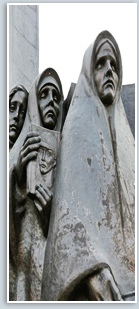BELARUS
![]()

Belarus is a landlocked country in Eastern Europe, that borders Russia to the north and east, Ukraine to the south, Poland to the west, and Lithuania and Latvia to the north. Its capital is Minsk; other major cities include Brest, Grodno, Gomel, Mogilev, Vitebsk and Bobruisk. A third of the country is forested, and agriculture and manufacturing are its strongest economic sectors.
Until the 20th century, the Belarusians lacked the opportunity to evolve a distinctive national identity, since the lands of modern-day Belarus belonged to several countries, including the Grand Duchy of Lithuania, the Polish-Lithuanian Commonwealth, and the Russian Empire. The final unification of Belarusian lands within its modern borders took place in 1939, when the ethnically Belarusian lands that were part of interwar Poland were annexed by the USSR and attached to the Soviet Belarus. The territory and its nation were devastated in World War II, during which Belarus lost about a quarter of its population and more than half of its economic resources.
Following the collapse of the Soviet Union, Belarus declared independence on August 25, 1991. Most of Belarus's population of 9.85 million reside in the urban areas surrounding Minsk and other oblast (regional) capitals. More than 80% of the population are native Belarusians, with sizable minorities of Russians, Ukrainians and Poles. The Constitution of Belarus does not declare an official religion, although the primary religion in the country is Russian Orthodox.
Although the Orthodox Church was decline until the early 1980s because of government policies, it underwent a small revival with the onset of perestroika and the celebration in 1988 of the 1,000-year anniversary of Christianity in Russia. In the 1990s, 60 percent of the population identified themselves as Orthodox (in 2006, however, 47.8% of citizens already declared themselves as irreligious, so the former number has dropped). Figures for the Catholic population in Belarus range from 8 percent to 20 percent; one estimate identified 25 percent of the Catholics as ethnic Poles. The revival of religion in Belarus brought about a revival of the old historical conflict between Orthodoxy and Roman Catholicism. Before World War II, the number of Protestants in Belarus was quite low in comparison with other Christians, but they have shown remarkable growth since then. In 1990 there were more than 350 Protestant communities in the country. The first Jewish communities appeared in Belorussia at the end of the fourteenth century and continued to increase until the genocide of World War II. The Soviet census of 1989 counted some 142,000 Jews, or 1.1 percent of the population, many of whom have since emigrated. There are nearly seventy Jewish organizations active in Belarus. Muslims in Belarus are represented by small communities of ethnic Tatars.

